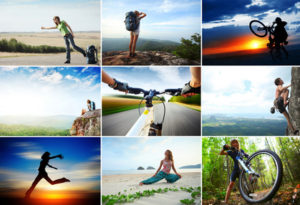 Sports Training can be complemented with a regular Yoga practice to increase your performance in other sports, through better flexibility, enhanced concentration and motivation or improved core strength. While yoga asana in itself is a complete form of physical practice, there are many ways how performance in other sports can benefit from a regular yoga routine.
Sports Training can be complemented with a regular Yoga practice to increase your performance in other sports, through better flexibility, enhanced concentration and motivation or improved core strength. While yoga asana in itself is a complete form of physical practice, there are many ways how performance in other sports can benefit from a regular yoga routine.
We will touch on just a few examples here and encourage you to talk to your yoga teacher for more detailed information before you start on a yoga-assisted training program. If required, your teacher can help you to develop a personal asana program for you.
Cycling and Yoga:
In cycling, isolated groups of muscles are used in a repetitive fashion. The common cycling posture is forward and inclined with an arched neck and pressure on the arms and wrists. As a result, many cyclists experience tight thighs (quadriceps), tight gluteal muscles and shortened hamstrings along with forward rotated shoulders and a tight neck and back. Hero pose (Virasana) can help lengthen the quadriceps while standing (Padanghustasana) and seated (Pascimattanasana) forward bends aid with a tight back and hamstrings. Downward facing dog is a great overall posture for opening up tight shoulders, upper back and neck muscles as well as lengthening the hamstrings and strengthening supporting muscles such as the leg adductors and core muscles.
Yoga for runners:
Running, whether it be on trails or on bitumen, requires to work against gravity – this is why it is such a great overall workout but it is also because of gravity that many runner-related imbalances occur: While you run, the force of impact on each foot is 3-4 times that of your weight and this impact is translated particularly into those areas of the body which cushion the impact – the ankle, knee and hip joints. The jarring motion of running (i.e. taking the right arm forward together with the left leg, thereby creating a counterforce between the upper and lower body) can also impact the back and particularly the delicate ‘hinges’ of the spine, known as ‘facet joints’, as well as the discs (the cushions of the spine). In order to protect these areas of higher impact, the body will strengthen certain muscles and these muscles may become tight whereas other muscle groups may weaken. Certain yoga postures can help to balance the runner’s body again and aid in recovery and better performance.
Supine (lying on your back) twists with either straight or bend legs to opposite sides are a great way to create space in the spine and stretch the gluteal muscles. Add hand-to-big-toe pose (Supta Padangusthasana) to your lying down routine and you also get a great stretch for your hamstrings. Navasana (boat pose) will help to build the deepest stomach (core) muscles, the transverse abdominus, and prone (lying on your belly) backbends such as grasshopper (Shalabasana) or cobra (Bhujangasana) pose will help to develop stabilising back muscles. Legs up the wall (Viparita Karani) is an ideal restorative pose, counteracting the gravity induced effects of running.
Rock-climbing and Yoga:
The greatest commonality between yoga and rock-climbing is the mindfulness or focus required if you want to climb well, with good technique and with as little effort as possible. Climbing, like yoga, requires overall strength (particularly in the core) as well as good flexibility. Depending on your level of climbing and personal inclination, you may never develop climbing-related muscle imbalances. However, if you are drawn to overhanging climbs that require a lot of upper body strength, you may find yourself with overdeveloped and slightly hunched shoulders, which, over time, can cause undue strain on the discs of the lower back due to the exacerbated forward curvature of the spine.
Yoga postures that particular target the muscles of the upper back (trapezius, rhomboids as well as lattisimus dorsi) are Garudasana (eagle pose) as well as cow pose (Gomukhasana). Setu Bandhasana (backbend) will also help to bring back the natural curvature of the lower spine as well relief tension in the upper spine. Finally, meditation and pranayama (breath work) are excellent techniques to still the mind and increase focus.
Please Note:
The above information is only given as a guide and should only be used as such. Only attempt these postures after you have had appropriate guidance from a qualified Yoga Teacher. To assist each individual student there are multiple variations for each asana (posture) to meet your personal level of health and well-being. If you are suffering from any injuries or illness, please consult with a qualified medical practitioner prior to engaging in these activities.

